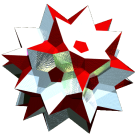general variant of expanded tetracontoctachoron,
general variant of expanded bicont
©
- general polytopal classes:
- isogonal
links

| Acronym | sobcotic |
| Name |
small bicuntitruncated tetracontoctachoron, general variant of expanded tetracontoctachoron, general variant of expanded bicont |
| |
| Circumradius | sqrt[a2+3ab+3b2+2ac sqrt(2)+4bc sqrt(2)+3c2] |
| Face vector | 1152, 3456, 3552, 1248 |
| Confer |
|
|
External links |

|
This isogonal polychoron cannot be made uniform, i.e. having all 4 edge types at the same size. It occurs as the Stott expansion either of cont (a=d=0, b=c) or its dual bicont (b=c=0), then surely being bound to b=c and hence d=a sqrt[2-sqrt(2)]. Accordingly then the trapezia bc&#d clearly would be rectangles only and the tics always are uniform. But that form can even be genaralized as described below, i.e. with b and c using independent edge sizes.
Note the general restriction c/sqrt(3) = r(c3o) < r(a3b) = sqrt[(a2+ab+b2)/3] mentioned below. That one assures that the triangles .. .. c.3o. always are farer from the center than the parallel hexagons .. .. .b3.a, so that the latter become pseudo faces only and hence don't occur here.
Several other polychora would occur as special cases, although as degenerate cases only as some edge sizes become zero. Accordingly in the respective incidence matrices not only several elements would vanish, but also several counts would be different, due to coincidences. Thence cf. to the individual pages then. Such examples are: cont (a=d=0, b=c), bitec (c=0), bamic (a=c=0), bicont (b=c=0), respic (b=0, a=2c), bimtec (a=0), ...
The above picture displays the a. .. c.3o. in blue, their adjacent ao .. cb ..&#d in yellow. The these joining ao .. .. oa&#d thus become fully burried. (They become perceptible by their vertices and d-edges only.) Whereas the b.4c.3o. and the .. bc4cb ..&#d are left blank in order to get a view into this structure. Obviously this picture uses the above already described outer symmetric variant with b=c.
Incidence matrix according to Dynkin symbol
ao3bc4cb3oa&#zd → height = 0
case: c/sqrt(3) = r(c3o) < r(a3b) = sqrt[(a2+ab+b2)/3]
d = sqrt[a2(2-sqrt(2))+2a(b-c)(3-2sqrt(2))+2(b-c)2(3-2sqrt(2))]
(d-laced tegum sum of 2 alternate (a,b,c)-gricos)
o.3o.4o.3o. & | 1152 | 1 1 2 2 | 2 2 1 3 4 | 1 1 3 1 2
------------------+------+-------------------+-----------------------+-------------------
a. .. .. .. & | 2 | 576 * * * | 2 0 0 2 0 | 1 0 2 1 0 a
.. b. .. .. & | 2 | * 576 * * | 0 2 0 0 2 | 0 1 1 0 2 b
.. .. c. .. & | 2 | * * 1152 * | 1 1 1 0 1 | 1 1 1 0 1 c
oo3oo3oo3oo&#d | 2 | * * * 1152 | 0 0 0 2 2 | 0 0 2 1 1 d
------------------+------+-------------------+-----------------------+-------------------
a. .. c. .. & | 4 | 2 0 2 0 | 576 * * * * | 1 0 1 0 0
.. b.4c. .. & | 8 | 0 4 4 0 | * 288 * * * | 0 1 0 0 1
.. .. c.3o. & | 3 | 0 0 3 0 | * * 384 * * | 1 1 0 0 0
ao .. .. ..&#d & | 3 | 1 0 0 2 | * * * 1152 * | 0 0 1 1 0
.. bc .. ..&#d & | 4 | 0 1 1 2 | * * * * 1152 | 0 0 1 0 1
------------------+------+-------------------+-----------------------+-------------------
a. .. c.3o. & | 6 | 3 0 6 0 | 3 0 2 0 0 | 192 * * * * trip variant
.. b.4c.3o. & | 24 | 0 12 24 0 | 0 6 8 0 0 | * 48 * * * tic variant
ao .. cb ..&#d & | 6 | 2 1 2 4 | 1 0 0 2 2 | * * 576 * * 2cup variant
ao .. .. oa&#d | 4 | 2 0 0 4 | 0 0 0 4 0 | * * * 288 * 2ap variant
.. bc4cb ..&#d | 16 | 0 8 8 8 | 0 2 0 0 8 | * * * * 144 ditetragonal trapezoprisms (op variant)
© 2004-2025 | top of page |